
JULIA LEE BARCLAY-MORTON – YOGA, WATER AND REWRITING AUTISM
I interviewed writer Julia Lee Barclay-Morton about her experience of autism. Julia began as an experimental dramatist in New York, moving to the UK to
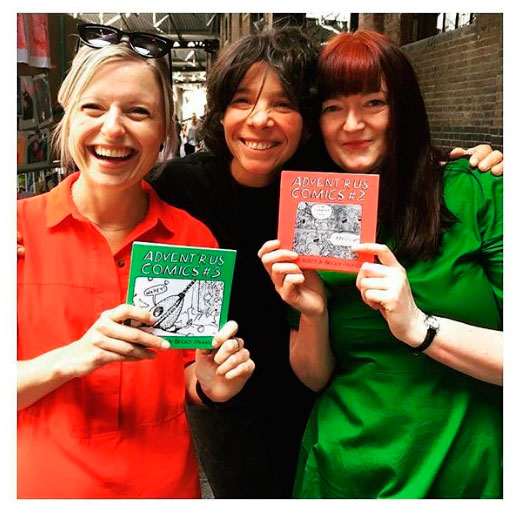
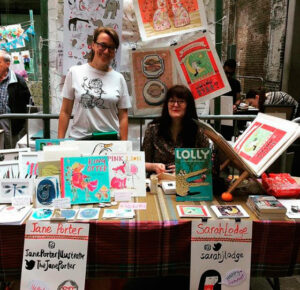
I interviewed children’s book illustrator Sarah Lodge, who has been shortlisted for the AOI World Illustration Awards New Talent Award, asking her what goes into her artwork for books and exhibitions. Sarah says about herself: “I would get more enjoyment and purpose out of a child picking up a book I had illustrated than I would from an artwork hanging on a gallery wall.”
Leslie: How did you begin as an artist? Who and what has helped and hindered your artistic development?
Sarah: I think from as soon as I could hold a pencil and scribble. I have drawings from when I was two years old; luckily my mother kept a file of all my drawings up until the age of six. They are mostly of the people and things around me, along with a few narrative sequences involving cats and dogs. A trip to the theatre left a big impression. Like many children school dampened my creative imagination for a bit, but I had a teacher when I was 10 or 11 who had been to art school and he set us the most amazing briefs: comic strips, observational drawing and 5 minute short poses to draw in a continuous line. Art lessons were my absolute favourite and my ten year old ambition was to write and illustrate my own stories. I think teaching, good or bad, can help and hinder in equal measure. I had some shockingly inept teaching on my Fine Art painting degree, but some incredible teaching on my illustration MA some twenty years later. In between I studied photography, life drawing and printmaking at adult education courses in the evenings, whilst I worked full time as a children’s bookseller. I don’t think there has ever been a time in my adult life when I wasn’t learning something creative. It would be impossible for me not to do it. I guess the demons that hinder are self-doubt and depression, and the only times I have stopped making (thankfully few) have been when I have been crippled with a lack of self worth.
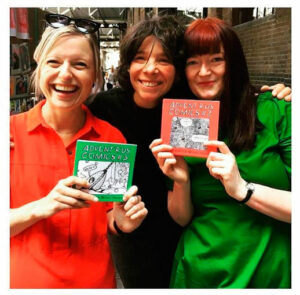
Leslie: Can you give us an overview your own work and the people you collaborate with such as Brolly Lolly, please? How does working collectively influence what you do?
Sarah: At the moment I would classify myself as a children’s book illustrator and a printmaker. This seems to be where it has settled for now although I still harbour fantasies of becoming a textile designer or a painter. Being surrounded by incredible children’s illustration for the whole of my working life perhaps made it inevitable that I should fall into this world. After finishing my Masters Degree at Cambridge School of Art I’ve kept in touch with some extraordinarily creative (mainly) women illustrators and I would say that the network we have is vital and nurturing – a life blood. Illustrating at home is quite an isolating experience, so any excuse to get together and share ongoing work is a must. Whether collaborating on a project, or merely running ideas past each other for feedback, it all feeds back into my own process. Brolly Lolly is a loose collective of children’s book illustrators who exhibit at print and comic fairs. Some of us are more about graphic novels and narrative fiction and others, like me, are more about printmaking. To be honest our coming together is largely for social reasons, but we have worked on a children’s activity book together. I love the collaborative process and would love to do more of it. Unfortunately as my commissioned illustration picks up it means I have less time for personal and collaborative work.
Leslie: What’s your step-by-step creative process for making an artwork? What rituals/routines do you follow?
Sarah: I can be very chaotic and it is hard for me to get started but once I am in the zone I am very focused. I usually start by trawling the internet for reference material and getting out and drawing observationally as much as I can. Once I’ve got to a point where I can’t faff about any more I start sketching out thumbnails and very rough ideas. I like to leave a lot of decisions until the ‘final’ artwork so it feels fresh and I can surprise myself. Once I am drawing I can be in the zone for hours.
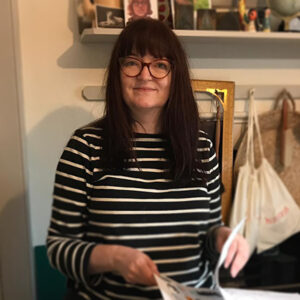
For my book work I mainly draw in pencil on paper, scan it into photoshop and colour it digitally. If I am planning a screenprint session I draw with ink on drafting film and plan my colour separations or layers by layering up the film on a lightbox. I use my lightbox and scanner for both illustration and printmaking and my digital work often mimics the way I make screenprints.
Leslie: What’s the creative difference between illustrating for publishers/authors and your own artwork for children?
Sarah: At the moment I am illustrating some chapter books for a publisher. The books are for children aged 5 to 8 and the illustrations are in black and white. My art director sends me the book to read and blocks out spaces where she wants me to illustrate a scene. She tells me what characters are in each scene, what they are doing and what emotions they are experiencing. It sounds restrictive but I love it. It takes a lot of the guess work out, and working with tight restraints can be very liberating – it means I only have to focus on what is necessary. Conversely if I am self-generating an artwork I have endless freedoms but it can be hard to narrow things down and finish stuff. Experimenting is necessary to keep one’s work fresh but without a context it can lose focus and remain underdeveloped. I love printmaking for this very reason. It forces me to plan, execute and finish a piece by the intrinsic nature of the process. It is slow, calming and therapeutic, and the results also feed into my illustrative practice.
Leslie: Could you tells us, please, about the Migrations Exhibition, The World Illustration Awards , Inktober and book covers you have designed.
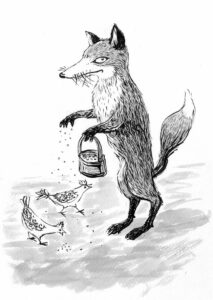
Sarah: The Migrations Exhibition was organised by illustration lecturers from the International Centre for the Picture Book in Society, (ICPBS) at the University of Worcester in association with the Biennial of Illustration, Bratislava. Hundreds of illustrators from all over the world were invited to send in a postcard bearing the illustration of a bird, representing the theme of migration. I dashed mine off in an evening and hand-painted my postcard on a cut piece of watercolour paper, it was quite refreshing not to work digitally for a change. An installation of the postcards ‘in flight’ was exhibited in Bratislava and then toured the world and Otter-Barry Books published a selection of the postcards in a little book last year.
The Association of Illustrators have an annual competition called the World Illustration Awards which is open to both professionals and students internationally, and in 2015 I was shortlisted for a panel I designed for Heffers Bookshop in Cambridge. Inktober is an online monthly art challenge devised by Jake Parker, which ‘focuses on improving and developing positive drawing habits’. The idea is to post a drawing every day in October with the hashtag #inktober done entirely in ink. I choose to do this because ink drawing was my nemesis and to get me into a routine of drawing every day in a fallow period. I think it’s important to enter competitions and participate in drawing challenges when there isn’t any commissioned work coming in, just to keep things ticking along, and to have a sense of structure and that all important deadline. Otherwise I find I can just drift. The book covers I have been commissioned for weren’t designed by me but I was approached by an art director who saw my degree show and kept me in mind. She was re-jacketing a trilogy by Joan Lingard (one of my favourite children’s authors) and thought my dramatic shadows would lead themselves to a series set in Victorian London. I hadn’t considered drawing for middle-grade fiction (ages 8 to 12) before and I fell in love with it and spent many a happy hour doing the historical research. I would love to do more for this age group.
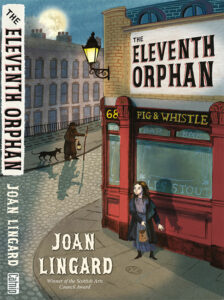
Leslie: What are the emotional/social/psychological rewards for working as a children’s illustrator?
Sarah: I think I partly fell into children’s book illustration by default after many years as a children’s bookseller but maybe it was always in me anyway. As a very small child I drew comic strips and made my own books. Often children’s first exposure to art is through illustrated books and we learn to ‘read’ visually long before we can put letters together and construct words and sentences. I think of all the creative adventures I have had, be they fine art painting, photography or printmaking, children’s illustrating is the most rewarding. Not because, to invoke the cliché, that I am ‘in touch with my inner child’, although this helps, but because I would get more enjoyment and purpose out of a child picking up a book I had illustrated than I would from an artwork hanging on a gallery wall. I’m not sure this answers your question fully but for me it is all about books and less about the art world, and always has been.
Next week I interview Northern Irish writer, film maker and opera stage manager Caroline Grebbell
ABOUT LESLIE TATE’S BOOKS:

I interviewed writer Julia Lee Barclay-Morton about her experience of autism. Julia began as an experimental dramatist in New York, moving to the UK to

I interviewed Gillean McDougall from Glasgow, who edited the collaborative projects Honest Error (on Charles Rennie Mackintosh and his wife Margaret Macdonald) and Writing the

I interviewed French writer Delphine de Vigan, whose book, No et moi, won the prestigious Prix des libraires. Other books of hers have won a clutch

I interviewed Joanne Limburg whose poetry collection Feminismo was shortlisted for the Forward Prize for Best First Collection; another collection, Paraphernalia, was a Poetry Book Society Recommendation. Joanne

I interviewed Katherine Magnoli about The Adventures of KatGirl, her book about a wheelchair heroine, and Katherine’s journey from low self-esteem into authorial/radio success and
| Cookie | Duration | Description |
|---|---|---|
| cookielawinfo-checkbox-analytics | 11 months | This cookie is set by GDPR Cookie Consent plugin. The cookie is used to store the user consent for the cookies in the category "Analytics". |
| cookielawinfo-checkbox-functional | 11 months | The cookie is set by GDPR cookie consent to record the user consent for the cookies in the category "Functional". |
| cookielawinfo-checkbox-necessary | 11 months | This cookie is set by GDPR Cookie Consent plugin. The cookies is used to store the user consent for the cookies in the category "Necessary". |
| cookielawinfo-checkbox-others | 11 months | This cookie is set by GDPR Cookie Consent plugin. The cookie is used to store the user consent for the cookies in the category "Other. |
| cookielawinfo-checkbox-performance | 11 months | This cookie is set by GDPR Cookie Consent plugin. The cookie is used to store the user consent for the cookies in the category "Performance". |
| viewed_cookie_policy | 11 months | The cookie is set by the GDPR Cookie Consent plugin and is used to store whether or not user has consented to the use of cookies. It does not store any personal data. |
2 responses
I really enjoyed this interview. It is wonderful that Sarah was able to develop her interest in art and end up working in a career she loves and is so good at.
🙂 🙂 🙂